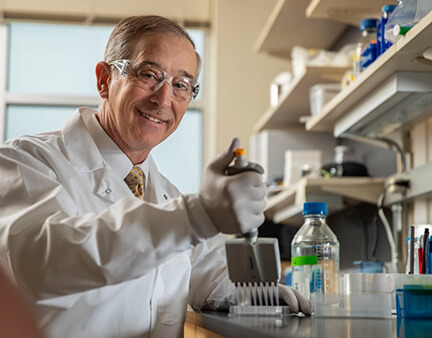How does the brain respond to sweet taste?

Robert Considine, Ph.D.
Professor of Medicine
Director, IBRI Diabetes Center
In 2018, IDC Director Dr. Robert Considine, who joined the IBRI last fall, and his team continued to conduct their research into diabetes and its complications and they made progress on a number of fronts.
With funding from the American Diabetes Association, Dr. Considine’s team continues to investigate how the brain responds to sweet taste, and how this response changes following gastric bypass surgery. A reduction in subject preference for sweet taste following surgery has been reported, but the brain areas responsible for this effect are unknown.
Using magnetic resonance imaging and the administration of sucrose to the tongue, the investigative team is measuring the activation of brain areas, including the primary gustatory cortex and reward areas. These studies may lead to a non-surgical solution to reduce the consumption of sweetened high-calorie foods and beverages.
The health benefit of nut consumption
Collaborator: Purdue University
In collaboration with Dr. Richard Mattes, a leading nutrition scientist at Purdue University’s College of Health and Human Sciences, Dr. Considine’s team is also studying the ingestion of almonds as a means to reduce blood sugar, which will determine if the health benefits of the nuts are driven by the presence of greater body fat in the abdominal or gluteal region.
A manuscript describing the findings of this two-year clinical trial will be published in 2019. This study continues a long-standing collaboration between Drs. Considine and Mattes, which has already yielded three publications on the health benefits of nut consumption.
The quest to regenerate beta cells
Partner: Juvenile Diabetes Research Foundation (JDRF)
In addition to the LDCE and Dr. Considine’s group, the IDC includes the IBRI’s Regenerative Medicine and Metabolic Biology (RMMB) group led by Dr. Teresa Mastracci. This team uses mouse and zebrafish models to determine how cells in the pancreas develop, differentiate and regenerate.
The RMMB group continued to advance several discovery-based projects aiming to slow the progression of diabetes, including the role of developmental pathways in stimulating beta cell regeneration, novel progenitor cell populations as innovative cell sources for the differentiation of beta cells in vitro, and small molecule and drug repurposing to stimulate beta cell regeneration.
The generous Career Development Award granted to Dr. Mastracci in 2016 from the Juvenile Diabetes Research Foundation (JDRF) was renewed in 2018 for a third year and will continue to fund many aspects of this work.
New genetic disease discovered
Partner: Columbia University
In a major breakthrough, a collaboration between Dr. Mastracci’s group and Dr. Wendy Chung’s laboratory at Columbia University Irving Medical Center in New York City resulted in the discovery of a new monogenic disease: DHPS Deficiency.
This project identified the first mutations in the human deoxyhypusine synthase gene encoding the enzyme DHPS. The enzyme is required for the production of the unique amino acid hypusine, which works in every cell of the body to help make proteins. The significance is that these mutations reduce DHPS enzyme activity, which leads to clinical symptoms in humans, including neurodevelopmental delay and seizures.
As a result of this work, the DHPS Foundation provided financial support to Dr. Mastracci to create and study animal models that mimic the human DHPS mutations. This work is necessary to identify therapeutic targets and strategies to reduce the burden of disease for patients suffering from DHPS Deficiency.